
|
One Moon Among Billions
- Click the image above for a larger view
- Full-Res JPEG (615 x 578) (22.1 kB)
- Full-Res TIFF (615 x 578) (356.1 kB)
Caption:
Sunlight reflects off the bright, frozen surfaces of the billions and billions of particles comprising Saturn's rings to brighten the planet's southern skies.
The particles in Saturn's rings are each too small to be seen by Cassini in this image. If they could, each would look like the bright reflective crescent of Enceladus (505 kilometers, 314 miles across) seen here, with each reflecting sunlight onto the southern hemisphere of the planet.
The image was taken in polarized infrared light with the Cassini spacecraft wide-angle camera on Nov. 2, 2005, at a distance of approximately 1.7 million kilometers (1.1 million miles) from Saturn and at a Sun-Saturn-spacecraft, or phase, angle of 119 degrees. The image scale is 104 kilometers (65 miles) per pixel.
Background Info:
The Cassini-Huygens mission is a cooperative project of NASA, the European Space Agency and the Italian Space Agency. The Jet Propulsion Laboratory, a division of the California Institute of Technology in Pasadena, manages the mission for NASA's Science Mission Directorate, Washington, D.C. The Cassini orbiter and its two onboard cameras were designed, developed and assembled at JPL. The imaging operations center is based at the Space Science Institute in Boulder, Colo.
For more information about the Cassini-Huygens mission visit http://saturn.jpl.nasa.gov . The Cassini imaging team homepage is at http://ciclops.org .
Cataloging Keywords:
| Name | Value | Additional Values |
|---|---|---|
| Target | Saturn Rings | Enceladus, Saturn |
| System | Saturn | |
| Target Type | Ring | Planet, Satellite |
| Mission | Cassini-Huygens | |
| Instrument Host | Cassini Orbiter | |
| Host Type | Orbiter | |
| Instrument | Imaging Science Subsystem (ISS) | |
| Detector | Wide Angle Camera | |
| Extra Keywords | Grayscale, Infrared, Visual | |
| Acquisition Date | ||
| Release Date | 2005-12-16 | |
| Date in Caption | 2005-11-02 | |
| Image Credit | NASA/JPL/Space Science Institute | |
| Source | photojournal.jpl.nasa.gov/catalog/PIA07654 | |
| Identifier | PIA07654 | |
